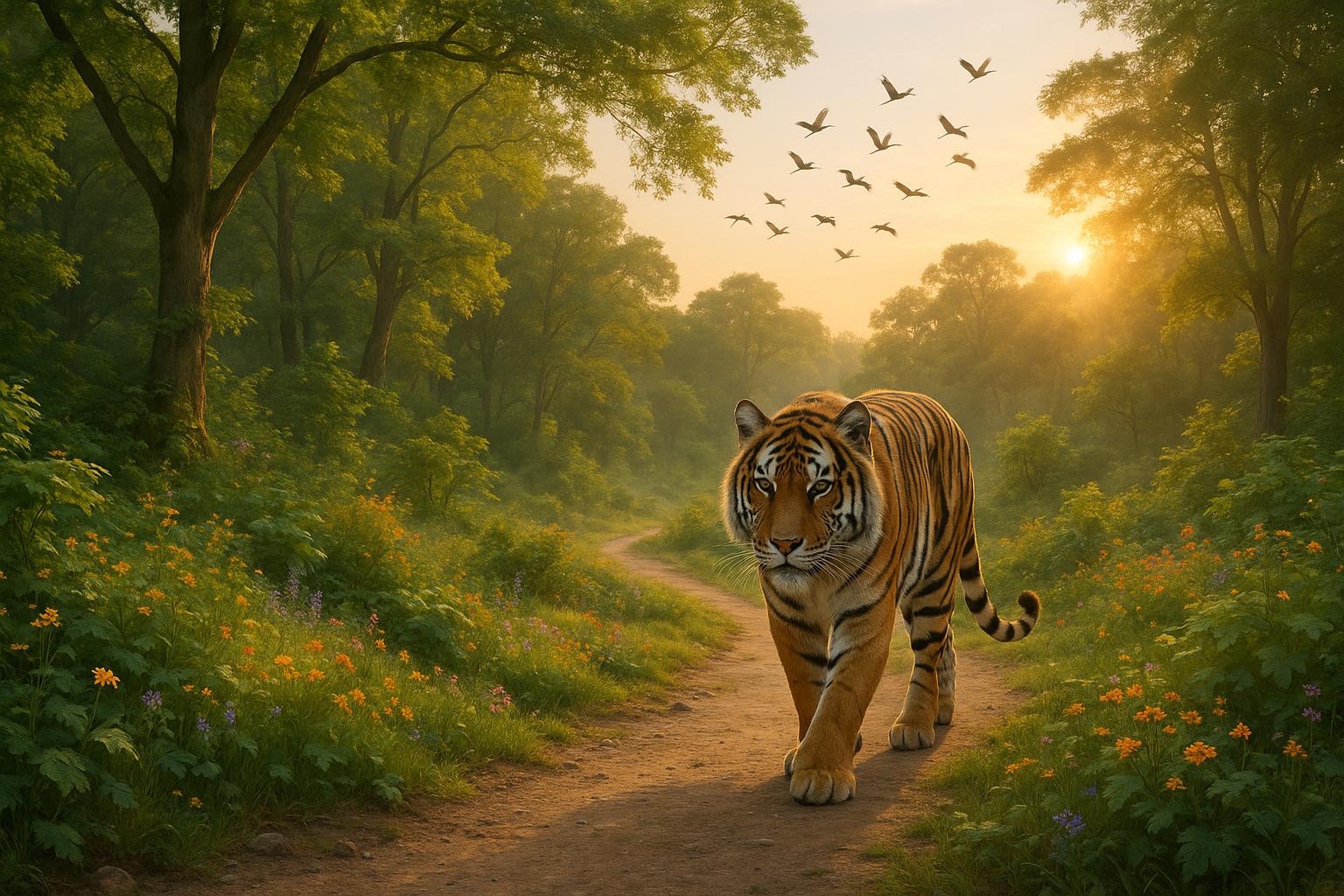
Top Wildlife Charities for Cause-Driven Gifting
Top Wildlife Charities for Cause-Driven Gifting
Want to make a difference while giving meaningful gifts? Wildlife charity gifts are an impactful way to support conservation efforts, protect endangered species, and restore habitats.
Here’s a quick snapshot of what you can do:
- Adopt an animal: Symbolic adoptions start as low as $10 and often include certificates, plush toys, or species fact sheets.
- Shop for a cause: Many charities offer eco-friendly merchandise, from apparel to home goods, with proceeds funding conservation work.
- Support global initiatives: From protecting rhinos in Africa to saving sea turtles in the oceans, your contributions can have worldwide impact.
Top wildlife charities to consider:
- World Wildlife Fund (WWF): Offers symbolic adoptions and conservation-themed merchandise.
- Wildlife Conservation Society (WCS): Focuses on keystone species and operates globally.
- Born Free Foundation: Supports compassionate conservation and predator-proof enclosures.
- Panthera: Protects wild cats and their habitats worldwide.
- Fauna & Flora International (FFI): Restores habitats and trains conservationists.
- Defenders of Wildlife: Partners with brands to fund conservation through purchases.
- International Rhino Foundation (IRF): Protects rhinos and their habitats in Africa and Asia.
- Jane Goodall Institute (JGI): Safeguards chimpanzees using community-driven strategies.
- Oceanic Society: Focuses on marine conservation and sea turtle preservation.
- GiftList: A tool to simplify gifting conservation-focused items and symbolic adoptions.
Quick Comparison Table
| Charity | Adoption Cost Range | Gift Items Included | Key Focus Areas | Locations Impacted |
|---|---|---|---|---|
| World Wildlife Fund | $25–$100 | Plush toys, certificates, fact sheets | Global conservation | Worldwide |
| Wildlife Conservation Society | $60+ | Plush toys, adoption docs | Keystone species, ecosystems | 14 regions globally |
| Born Free Foundation | $33+ | Certificates, plush toys (optional) | Compassionate conservation, rescues | 20+ countries |
| Panthera | $500+ | Naming opportunities | Wild cats and habitats | 35+ countries |
| Fauna & Flora Intl. | $25+ | Organic apparel, tribute funds | Habitat restoration, species protection | 48 countries |
| Defenders of Wildlife | Varies | Partnerships with brands | Endangered species, habitats | U.S. focus |
| International Rhino Foundation | $50+ | Digital certificates, updates | Rhino conservation | Africa, Asia |
| Jane Goodall Institute | $50+ | Chimpanzee adoptions, branded gifts | Chimpanzee habitats | Africa |
| Oceanic Society | $40–$1,000 | Certificates, naming opportunities | Marine life, plastic pollution | Marine environments |
| GiftList | Varies | Curated wish lists | Conservation gifting | Global |
Whether you’re adopting a tiger, buying eco-friendly gifts, or supporting marine cleanups, these charities make it easy to give back. Choose a cause you care about and make a lasting impact.
1. World Wildlife Fund (WWF)

Animal Adoption Programs
WWF offers symbolic animal adoptions that let donors contribute to conservation efforts while giving a thoughtful gift. Their adoption kits are available at three levels:
- $25 Basic Kit: Includes a 5" x 7" adoption certificate and a species spotlight card featuring a photo and key facts.
- $60 Premium Kit: Adds a plush animal (suitable for ages 3 and up) to the basic kit.
- $100 Deluxe Kit: Includes everything in the premium kit, plus a WWF gift box and a double display frame for showcasing the certificate and photo.
Gift Shop Items
The WWF gift shop features a wide range of conservation-themed products. The 2025 Tiger Collection highlights include:
- Apparel such as T-shirts and sweatshirts
- Educational puzzles
- Traditional nesting dolls
- Customizable "build your own bucket" options
Main Conservation Work
WWF dedicates its efforts to six key areas of conservation:
- Climate protection
- Sustainable food systems
- Forest conservation
- Freshwater preservation
- Ocean protection
- Wildlife conservation
Their work has led to notable successes, such as increasing black rhino populations in southern Africa and advancing tiger conservation efforts across Asia.
Where They Work
WWF operates in nearly 100 countries, directing 85% of its funding toward conservation projects across six continents. For instance, their tiger conservation program collaborates with 13 nations to double wild tiger populations, while communal conservancies in Namibia enhance local wildlife protection.
Up next, take a look at another prominent organization making strides in wildlife conservation.
2. Wildlife Conservation Society (WCS)
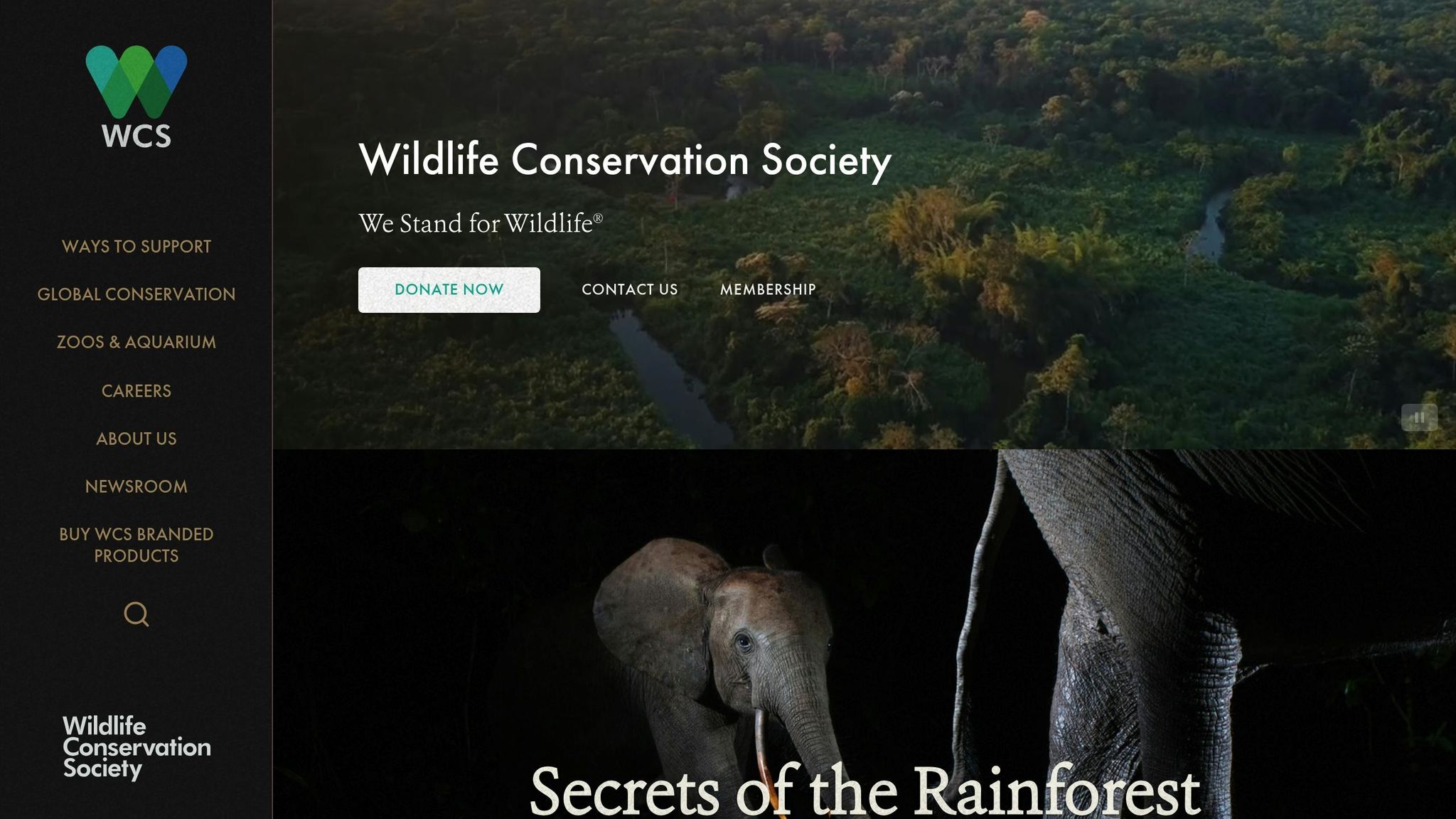
Animal Adoption Programs
The Wildlife Conservation Society (WCS) offers symbolic adoptions through the Bronx Zoo to support its conservation efforts. These adoptions make for a meaningful gift while contributing to real-world conservation work. Each adoption package includes a plush animal, a fact card with a photo, and an adoption certificate. For U.S. residents, these adoptions may also be tax-deductible.
Gift Shop Items
WCS operates gift shops at several of its locations, including the Bronx Zoo, New York Aquarium, Central Park Zoo, Prospect Park Zoo, and Queens Zoo. One standout initiative is the Save the Wild collection, where all profits are directed toward conserving elephants, lions, and rhinos.
Main Conservation Work
WCS is dedicated to protecting keystone species and their habitats. Its approach includes a mix of scientific research, direct action, community engagement, policy advocacy, addressing climate change, and combating wildlife trafficking. By focusing on iconic species, WCS ensures the protection of entire ecosystems, benefiting countless other species that share these habitats.
Where They Work
WCS operates in 14 priority regions that support nearly half of the world’s biodiversity. Their conservation work spans:
- Africa: Covering 16 countries, including Kenya, Tanzania, and Uganda
- Asia: Active in 18 nations, from India to Mongolia
- The Americas: Working across 13 countries in North and South America
- Critical Ecosystems: Focusing on areas like Arctic Beringia, Mesoamerica, the Western Caribbean, and key ocean territories
WCS collaborates closely with indigenous communities and local governments to ensure conservation efforts are sustainable. Their work includes creating wildlife corridors, supporting protected areas, and developing science-driven conservation strategies.
Next, we’ll take a closer look at another organization making strides in wildlife conservation.
3. Born Free Foundation
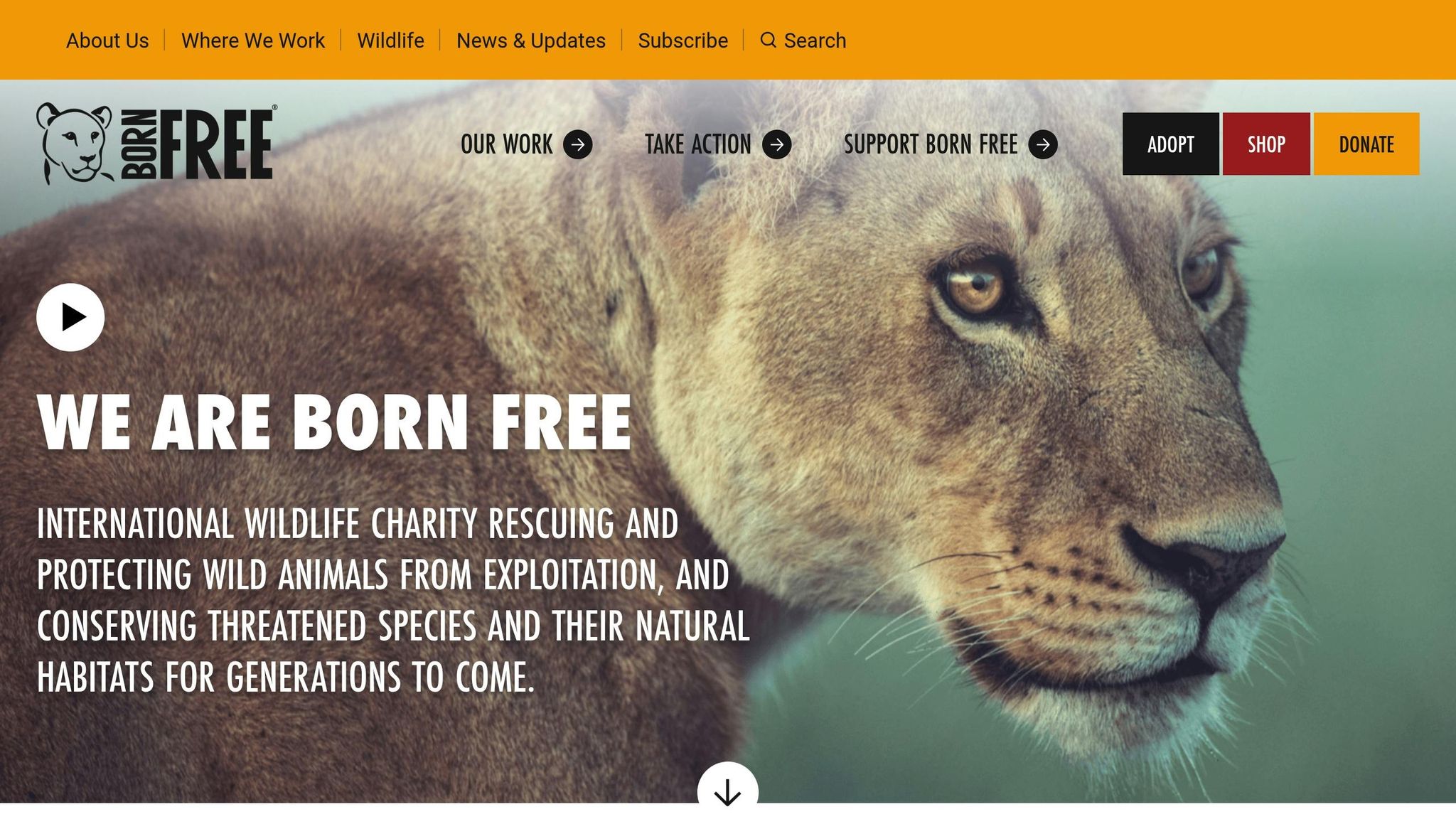
Animal Adoption Programs
The Born Free Foundation runs a symbolic animal adoption program that helps fund conservation efforts and animal rescues. This program focuses on a variety of species, including lions, elephants, tigers, orangutans, rhinos, pangolins, gorillas, leopards, giraffes, cheetahs, orcas, and brown bears. Adopters can select either a digital or physical welcome pack. Opting for digital adoptions ensures that 33% more of the fee is directed toward animal care. Each adoption package includes a personalized certificate, a photo with details about the adopted animal, a species fact sheet, and bi-annual magazine updates. Physical packs also offer the option to include a plush toy.
By adopting an animal, supporters contribute directly to vital conservation efforts.
Main Conservation Work
The Born Free Foundation is dedicated to compassionate conservation. For example, their Kenya lion project achieved a 25% increase in the lion population, bringing it to 2,500 by 2020. After the "Pride of Kenya" art exhibition in Nairobi in 2010, the Foundation collaborated with Masai communities to introduce predator-proof bomas. These enclosures protect livestock and reduce conflicts with predators like lions and hyenas.
Such initiatives demonstrate their commitment to addressing conservation challenges.
Where They Work
Born Free operates in over 20 countries across Africa, Asia, Europe, and the Americas. Their sanctuary network spans locations in South Africa, Ethiopia, and India. Among their long-standing projects are the Amboseli National Park elephant study, which began in 1992, and their partnership with Oxford University to protect Ethiopian wolves, ongoing since 1995. Their work encompasses a range of issues, including combating captive animal exploitation, trophy hunting, and wildlife trade. They also focus on rescue and rehabilitation, fostering coexistence between communities and wildlife, protecting UK wildlife, shaping conservation policies, and providing education on these critical topics.
4. Panthera
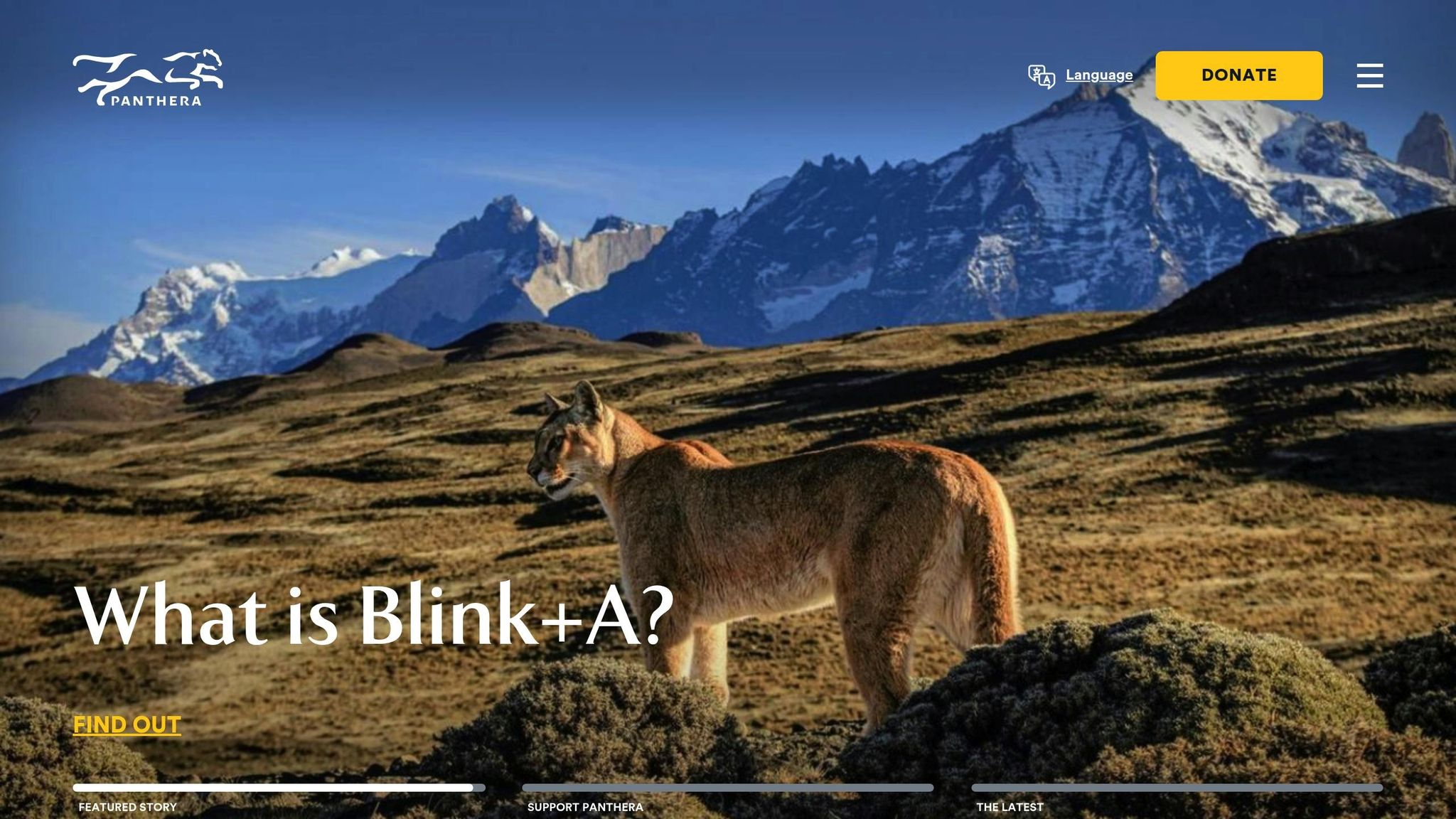
Main Conservation Work
Panthera is dedicated to safeguarding all 40 wild cat species, with a strong focus on seven major ones - cheetahs, jaguars, leopards, lions, pumas, snow leopards, and tigers. At the same time, they implement strategies for lesser-known species like fishing cats, ocelots, and Andean cats.
Their efforts have led to some impressive conservation milestones. In August 2010, Panthera partnered with the Belize government to create the Labouring Creek Jaguar Corridor Wildlife Sanctuary, protecting over 7,000 acres of jaguar habitat. Another standout achievement came in Myanmar, where Panthera's CEO, Alan Rabinowitz, played a pivotal role in expanding the Hukawng Valley Tiger Reserve by 4,248 square miles, making it the largest tiger reserve in the world.
These accomplishments are backed by Panthera's expansive global partnerships and efforts.
Where They Work
Panthera operates in more than 35 countries across eight regions, maintaining seven counter-wildlife crime hubs and collaborating with over 45 governments. Their regional offices are strategically located in key areas, including the Americas (Brazil, Canada, Colombia, Costa Rica, Honduras, United States), Europe (France, United Kingdom), Africa (Senegal, South Africa, Zambia), and Asia (Malaysia, Thailand).
The organization works closely with NGOs, scientific groups, and government agencies to advance their conservation goals. For example, in early 2010, Panthera partnered with the Johor State government in Malaysia and the Wildlife Conservation Society on a camera project. This effort captured a rare image of a spotted leopard in an area previously thought to host only black leopards.
"Panthera's mission is to ensure the future of wild cats and the vast landscapes on which they depend through scientific leadership and global conservation action. We envision a world where wild cats thrive in healthy natural and developed landscapes that sustain people and biodiversity."
5. Fauna & Flora International
Main Conservation Work
With a history spanning over 120 years, Fauna & Flora International (FFI) has made a remarkable impact by protecting and restoring more than 55 million hectares of habitat around the globe. In 2023 alone, FFI supported conservation efforts for 110 priority species and trained 6,300 individuals. Their initiatives have also helped prevent nearly 3.6 gigatonnes of CO₂ emissions. Impressively, 89% of all donations directly fund their conservation work.
FFI's conservation strategy revolves around three key areas:
- Protecting and restoring habitats
- Saving endangered species from extinction
- Creating sustainable livelihoods for communities living near nature
Where They Work
FFI operates in 48 countries, relying on a partnership-based conservation model. Their efforts span diverse regions, including:
- The Caribbean
- Central America
- Africa
- Eurasia
- Asia-Pacific
Their achievements across these regions are inspiring. In the Caribbean, FFI has restored 30 islands over the past three decades, successfully saving more than a dozen species from extinction. In Cambodia's Cardamom Mountains, they collaborate with government bodies and local communities to safeguard the remaining wild Siamese crocodile populations.
"Fauna & Flora International saves endangered species and habitats around the world. I'm proud to have been a member for over 50 years." – Sir David Attenborough OM FRS
Gift Shop Items
FFI's shop offers a selection of organic cotton T-shirts, hoodies, jumpers, and caps, with all proceeds going toward their conservation projects. While they don’t provide traditional animal adoptions, they do offer thoughtful gifting options such as tribute funds and honor donations, allowing supporters to contribute in meaningful ways.
"If you value the natural world - if you think it should be protected - then please support Fauna & Flora." – Sir David Attenborough OM FRS, Vice-president
6. Defenders of Wildlife

Main Conservation Work
Defenders of Wildlife focuses on protecting endangered species and their habitats by working through carefully planned partnerships.
Gift Shop Items
Instead of running a traditional gift shop, Defenders of Wildlife collaborates with brands that sell wildlife-themed products. A portion of the proceeds from these products directly supports conservation efforts. Some of their notable partnerships include:
- Thanksgiving Coffee: 20% of every Defenders-branded coffee purchase goes toward conservation efforts.
- Whip City Candle: 50% of sales from Defenders-branded candles is donated.
- Jim Morris Wildlife T-Shirt Company: 15% of purchases help fund wildlife protection initiatives.
- SunRidgeFarms®: At least 1% of the sales from their Berries & Chocolate Antioxidant Mix supports conservation work.
"Our animal adoption program aimed to inspire a love of wildlife conservation; closing it lets us channel resources more directly into protecting habitats."
Alternative Gifting Options
Defenders of Wildlife offers several other ways for supporters to contribute, making it easy to give back while shopping or gifting:
- Gift Memberships: Available via phone or mail for those who want to support conservation while giving a meaningful gift.
- Online Shopping: Purchases through CauseNetwork at retailers like Target, Kohl's, and Macy's generate donations.
- Gift Cards: GiftBar donates 5% of gift card purchases to conservation efforts.
- Vehicle Donations: Donating a vehicle is another way to support wildlife protection.
7. International Rhino Foundation

Main Conservation Work
The International Rhino Foundation (IRF) has been at the forefront of efforts to protect rhinos worldwide, channeling over $20 million into conservation initiatives. Their work is grounded in six core areas: protection, habitat restoration, community support, conservation breeding, demand reduction, and research. Operating with an annual budget of about $5 million, IRF ensures that 90% of donations go directly to field programs. Their reach spans both Africa and Asia, focusing on safeguarding the five remaining rhino species. Here's a closer look at their global impact.
Where They Work
IRF's conservation efforts are concentrated in key regions:
- Africa: Focused on Zimbabwe's lowveld conservancies, where they’ve made strides in protecting black rhinos.
- Asia: Partnering with local organizations in:
- Indonesia: Supporting the recovery of Sumatran rhino populations.
- Java: Protecting the critically endangered Javan rhinos in Ujung Kulon National Park.
- India: Spearheading the Indian Rhino Vision 2020 project in Assam to increase Indian rhino populations.
These initiatives highlight IRF's tailored, region-specific strategies to address conservation challenges.
"IRF is dedicated to the survival of the world's rhino species through conservation and research." – International Rhino Foundation (AAZK)
Animal Adoption Programs
To complement their conservation work, IRF offers symbolic rhino adoptions. Donors receive a digital certificate, a rhino bio with a photo, conservation updates, and a special adoption sticker. One standout option is adopting Rocky, a black rhino, which supports conservation efforts in Java, Sumatra, or Zimbabwe.
Gift Shop Items
IRF's online store features a variety of items, including apparel, accessories, home goods, and unique gift options. Every purchase directly contributes to funding their conservation initiatives across Africa and Asia.
sbb-itb-309de5c
8. Jane Goodall Institute
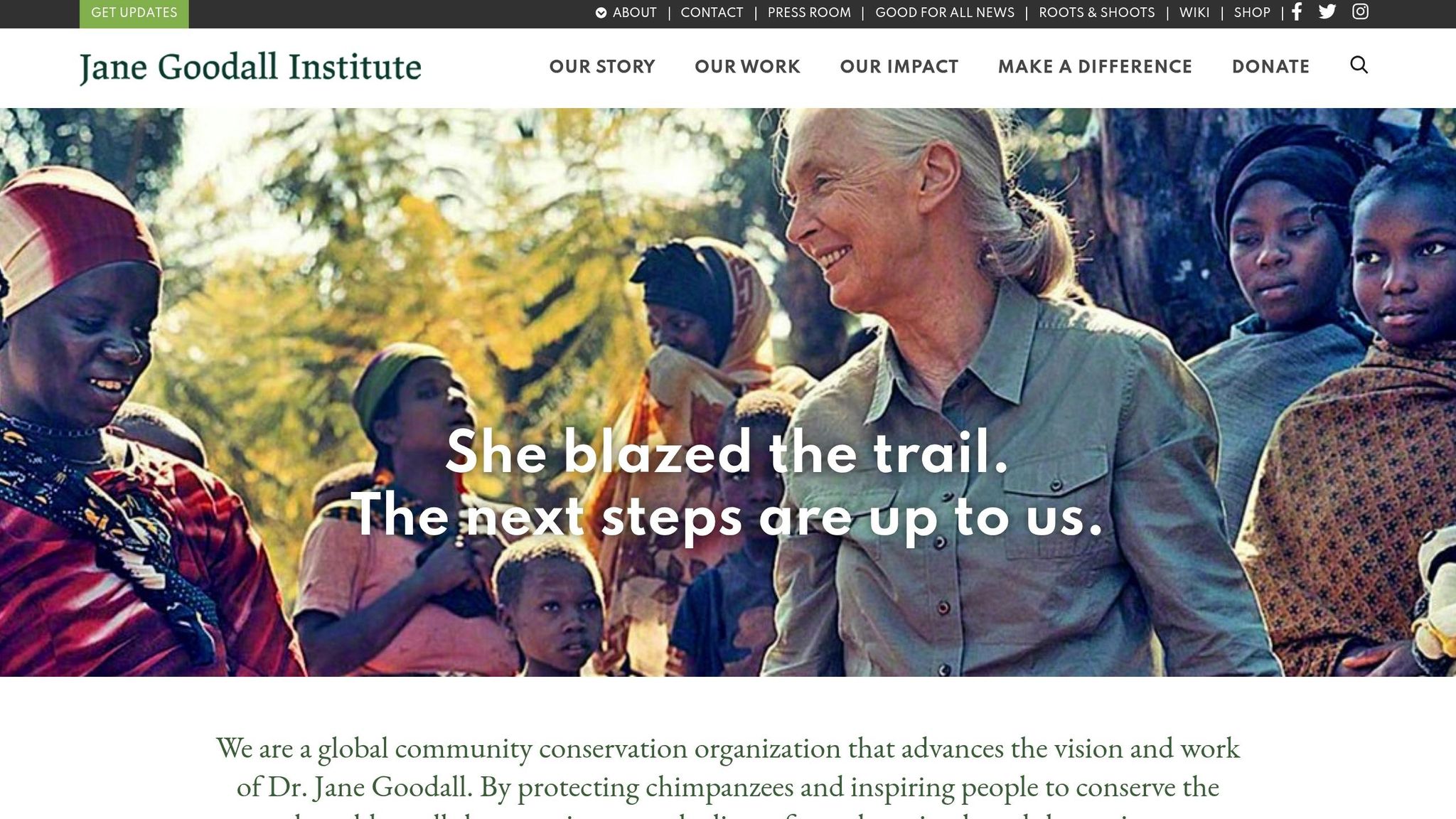
Main Conservation Work
The Jane Goodall Institute (JGI) blends cutting-edge technology with community-focused conservation strategies to safeguard chimpanzees and their habitats. By leveraging satellite imagery and drones, JGI monitors habitat conditions and tracks chimpanzee populations, helping guide informed conservation efforts. Over the last century, chimpanzee numbers have plummeted from about 1 million in 1900 to just 340,000 today. To combat this decline, JGI has developed conservation plans across 34 designated ecoregions, known as "Chimpscapes".
Let’s take a closer look at where JGI directs its conservation efforts.
Where They Work
JGI's conservation initiatives target key regions across Africa:
- Democratic Republic of the Congo: This area, home to the world’s second-largest rainforest, shelters an estimated 70,000–100,000 chimpanzees. JGI oversees a conservation plan covering 66 million acres, aiming to protect around 35,000 chimpanzees and 3,000 gorillas.
- Republic of Congo: The site of the Tchimpounga Chimpanzee Rehabilitation Center, a cornerstone of JGI's work.
- Tanzania and Uganda: Focus areas for community-driven conservation projects.
- West Africa: Active programs in Senegal and Mali address regional conservation challenges.
Animal Adoption Programs
JGI’s "Chimpanzee Guardian" program allows supporters to symbolically adopt orphaned chimpanzees, providing critical funding for their care at the Tchimpounga Sanctuary. Highlighted in the Holiday Gift Guide, these adoptions offer a heartfelt way to support wildlife conservation.
Gift Shop Items
JGI’s online store features a variety of items that help fund its mission. The 2024 Holiday Gift Guide showcases Jane Goodall and JGI-branded merchandise, educational resources, and conservation-themed products. Shoppers can also enjoy a 15% discount on their purchases by using the code GIFTGUIDE2024.
9. Oceanic Society

Main Conservation Work
Oceanic Society is committed to protecting marine life, with a strong focus on sea turtle preservation, promoting behaviors that benefit ocean health, and tackling plastic pollution. Their sea turtle conservation efforts, including the State of the World's Sea Turtles (SWOT) Program, address threats to six out of the seven sea turtle species. In July 2022, they introduced the Traveler Plastic Pollution Offset Program, which funds the removal of 200 pounds of trash per traveler on multi-day expeditions. By May 21, 2025, this program had successfully cleared over 25 tons of marine debris from Watamu's coastline.
Where They Work
Oceanic Society operates across marine environments worldwide. One of their standout efforts is in Watamu, Kenya, where local beach cleaning teams work tirelessly to safeguard coastal ecosystems. In 2023, their Global Ocean Cleanup campaign brought together more than 3,100 volunteers, who collectively removed 88,004 pounds of trash from coastal and marine areas. To further engage the public, they also offer symbolic animal adoption programs, enabling individuals to contribute directly to conservation efforts.
Animal Adoption Programs
Oceanic Society provides symbolic animal adoptions as a way for supporters to contribute to their mission. Here’s a quick look at the options:
| Animal Type | Duration | Cost | Special Features |
|---|---|---|---|
| Sea Turtle | 1 year | $50 | Personalized certificate |
| Whale | 1 year | $60 | Personalized materials |
| Whale | 2 years | $100 | Extended support package |
| Dolphin | 1 year | $40 | Conservation support |
For those looking to make a more personal impact, unique naming opportunities are available:
- Name a Leatherback Turtle: $500
- Name a Whale: $1,000
Gift Shop Items
Oceanic Society also runs an online store featuring eco-friendly apparel, accessories, and home goods. Every purchase directly supports their marine conservation efforts.
10. GiftList
Gift Shop Items
GiftList simplifies the process of giving back to wildlife conservation with its universal wish list tool. This platform allows users to compile a shareable list of items, including merchandise from wildlife charity shops. For example, you can add products from the Turpentine Creek Wildlife Refuge shop, which offers items like drinkware, apparel, toys, and home decor that directly support conservation efforts.
Animal Adoption Programs
GiftList goes beyond merchandise by spotlighting a variety of animal adoption programs. These programs cater to different budgets and species, making it easy to find a meaningful gift:
| Organization | Adoption Type | Cost | Includes |
|---|---|---|---|
| World Wildlife Fund | Symbolic Species | $60+ | Plush animal |
| Oceana | Marine Wildlife | From $10 | Digital certificate |
| Turpentine Creek | Wildlife Refuge | $150 | Photo and bio certificate |
In addition to these options, GiftList offers tools to help you plan for special occasions. For instance, you can use their special occasions tracker to schedule thoughtful conservation gifts, such as symbolic adoptions through the Sheldrick Wildlife Trust. This organization has successfully rescued and raised 265 orphaned elephants and 17 rhino calves in Kenya.
GiftList also curates guides for cause-driven gifting, highlighting impactful programs like the Born Free Foundation's predator-proof bomas initiative. This program has safeguarded approximately 32,500 livestock belonging to 2,500 people in Kenya's Amboseli region, ensuring wild predators can thrive alongside local communities.
Christmas gift ideas | Irish Wildlife Trust shop
Quick Comparison of Wildlife Charity Gift Options
Here's a snapshot of wildlife charity gift options available as of May 2025:
| Charity | Adoption Cost Range | Gift Items Included | Focus Areas | Location Impact |
|---|---|---|---|---|
| World Wildlife Fund | Varies | Plush animal, adoption certificate, species fact sheet | Global wildlife conservation and habitat protection | Global impact |
| Wonders of Wildlife | $20–$80 | Ocean Hero Package: 12-inch sea turtle plush, adoption docs, certificate, fact card, photo | Marine life and bird conservation | U.S.-based programs |
| Toucan Rescue Ranch | $100–$500 | Classic: Certificate, info pack, digital content Celebrity: Includes video call and social media mention |
Wildlife rescue and rehabilitation | Costa Rica-focused |
| National Wildlife Federation | $40 | Eco-Friendly Adoption Kit and educational materials | Tree planting and wildlife habitat restoration | U.S. nationwide |
| Polar Bears International | $25+ | Certificate with photo, newsmagazine, and sticker | Arctic wildlife conservation | Arctic regions |
| NatureServe | $25–$5,000 | Digital certificate and species information | Biodiversity protection and species monitoring | North America |
What Sets These Programs Apart?
- Toucan Rescue Ranch: Their Celebrity Adoption at $500 includes a 15-minute video call with staff and a shoutout on social media. Perfect for those wanting a more personal touch.
- Wonders of Wildlife: Offers a tiered system. The Ocean Hero Package ($80) comes with a plush toy and full documentation, while the Ocean Advocate Package ($20) focuses on essential certificates and fact cards.
- Polar Bears International: Their adoption kit features a newsmagazine and unique photography, adding an educational and visual component.
- NatureServe: Uses a sliding cost scale from $25 to $5,000, with pricing tied to the conservation status of the species being supported.
Things to Keep in Mind
When choosing a charity, consider these key factors:
- Geographic Impact: Some programs focus globally, while others are region-specific.
- Gift Options: Decide between physical keepsakes like plush toys or digital-only materials.
- Price Range: Options start as low as $20 and go up to $5,000, catering to different budgets.
- Species Focus: Some charities support a broad range of species, while others target specific ones.
This variety ensures there's an option to suit every interest and budget while contributing to meaningful conservation efforts.
Summary
Wildlife charity gifts play a crucial role in driving conservation efforts. With vertebrate populations declining by a staggering 73% since 1970, the need for action has never been more urgent.
"Without species, places can't perform their functions properly which will impact people." - Becky Chaplin-Kramer, Global Biodiversity Lead Scientist, Global Science, WWF
These gifts help fund essential research, restore habitats, and raise awareness about conservation challenges. For example, the David Shepherd Wildlife Foundation recently made a $14 million investment, showcasing how individual contributions can lead to collective impact.
GiftList simplifies the process of giving to conservation causes. This platform lets users create and share curated lists of wildlife charity gifts, ensuring no special occasion is overlooked with its Special Occasions Tracker.
"The value of wildlife goes beyond physical metrics like a kilogram of meat or a ton of carbon stored. It's spiritual, and experiences with wildlife can bring much enjoyment and connection with nature to people." - Robin Naidoo, WWF's lead wildlife scientist
When choosing a wildlife charity gift, keep these factors in mind:
- Transparency: Look into how donations are used by the organization.
- Impact Focus: Opt for charities addressing specific conservation goals.
- Gift Type: Decide between physical adoption kits or digital materials.
- Geographic Scope: Choose whether to support local or global conservation initiatives.
Every wildlife charity gift contributes to meaningful progress, turning individual generosity into tangible conservation outcomes.
FAQs
What should I consider when choosing a wildlife charity for a meaningful gift?
When choosing a wildlife charity as a meaningful gift, it’s important to consider the organization’s mission and the difference they’re making. Look for charities that focus on specific conservation efforts, such as safeguarding endangered species or protecting natural habitats. To ensure your chosen charity is trustworthy, check independent charity ratings that assess transparency and effectiveness.
Once you’ve identified a credible organization, take a look at their gift options. Many well-established charities offer symbolic adoptions or donation-based gifts, which allow you to support their work while giving your loved ones something special. These kinds of gifts not only help wildlife but also add a personal and thoughtful touch to your gesture.
How do symbolic animal adoptions help wildlife conservation?
Symbolic animal adoptions are a meaningful way to support wildlife conservation. By participating, you're contributing to efforts that protect endangered species, restore natural habitats, and fund essential research aimed at preserving biodiversity.
These adoptions also foster a personal connection to conservation. They encourage individuals to become active advocates for wildlife protection. The money raised typically goes straight to initiatives like habitat preservation and species recovery programs, directly aiding efforts to safeguard the planet's incredible array of wildlife.
How do wildlife charities make sure my donation supports global conservation efforts?
Wildlife charities amplify the reach of your donation by tackling conservation challenges on both local and global levels. They often collaborate with communities, governments, and other organizations to develop programs that protect wildlife while also benefiting the people who rely on these ecosystems for their livelihoods.
Your contributions typically support essential initiatives such as preserving habitats, recovering endangered species, and promoting environmental education. These efforts play a key role in restoring ecosystems, encouraging biodiversity, and creating lasting advantages for both wildlife and surrounding communities. This balanced strategy ensures your donation makes a tangible difference across the globe.


